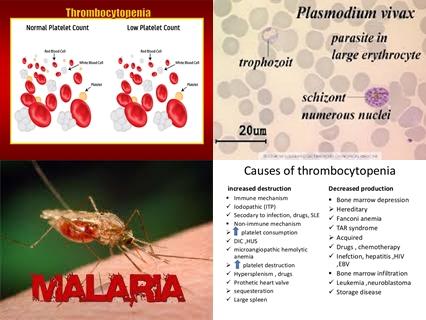
Objectives:
Plasmodium vivax (P. vivax) is the most geographically widespread species among human malaria parasites. Immunopathological studies have shown that platelets are an important component of the host innate immune response against malaria infections. Therefore, this review article (meta-analysis) has been conducted.
The aim of this review article is to quantify thrombocytopaenia in plasmodium vivax malaria patients and to determine the associated risks of severe thrombocytopaenia in patients with plasmodium vivax malaria compared to patients with plasmodium falciparum malaria.
Study design:
This review article included 58 observational studies (5,536 patients had thrombocytopaenia among a total of 29,664 patients investigated) across 12 endemic countries.
29 of 58 studies were prospective studies. Of them, the vast majority of participants infected with P. vivax (66%, 19 552/29664) were from a single large study conducted in Indonesia. Half of the studies were conducted in India (50%) and the study period covered the years 1988-2015. Only 25% of the included studies had PCR confirmation of parasite species.
Not all studies included in this review used the same methods for platelet “labelling”.
Results and conclusions:
The investigators found pooled analysis showed that 18.7% [95% CI = 17.0-20.2%] of patients with P. vivax malaria had platelet counts 150 000/mm3. Of these, 10.1% [95% CI = 9.0-10.8%] of the patients infected with P. vivax had either severe thrombocytopaenia (9%) or very severe thrombocytopaenia (13%).
There was an absence of statistical heterogeneity [I2 = 0%], suggesting a high level of homogeneity between studies in each gradient of thrombocytopaenia.
The investigators found a meta-analysis of 11 observational studies showed an equal risk of developing severe/very severe thrombocytopaenia between the patients with P. vivax malaria and those with P. falciparum malaria [OR = 1.98, 95% CI = 0.92-4.25], indicating that thrombocytopaenia is as equally a common manifestation in P. vivax and P. falciparum malaria patients.
In a subgroup of 3 studies, a pooled analysis showed patients with severe P. vivax malaria and those with severe P. falciparum malaria had an equal risk of developing severe/very severe thrombocytopaenia.
Further stratification by age groups showed children with severe P. vivax malaria (60/278) had a higher risk of developing very severe thrombocytopaenia than in those with severe P. falciparum malaria (13/145) [OR = 2.80, 95% CI = 1.48-5.29]. However an equal risk was observed for adult severe cases with P. vivax malaria and those with P. falciparum malaria [45/186 vs 70/207, OR = 1.19, 95% CI = 0.51-2.77, p = 0.22].
The investigators found in a subset of 4 studies a decreased platelet counts in patients with P. vivax malaria compared to the healthy controls [p 0.001 in all four studies].
The investigators found a pooled analysis of 4 studies showed that 15% [95% CI = 9-21%] of P. vivax malaria patients with thrombocytopaenia developed minor bleeding episodes. These bleeding manifestations were epistaxis, haematemesis, petechiae and purpura.
The investigators found a pooled analysis of 2 studies with PCR confirmed parasite species showed an equal risk of mortality with severe thrombocytopaenia in P. vivax malaria patients (10.2%, 5/49) and P. falciparum malaria patients (14%, 8/57) [OR = 1.16, 95% CI = 0.30-4.60, p = 0.87].
The investigators concluded there is some evidence of the clinical relevance of severe thrombocytopaenia in P. vivax malaria patients. However, due to the low number of studies with small sample sizes within the subset of studies that provided clinically relevant information, the confidence in the estimates is limited. Therefore, there is a need for future well designed, large-scale, prospective studies among patients infected with P. vivax from different countries and epidemiological settings with various age and gender groups represented to substantiate these findings.
Original title:
Severe thrombocytopaenia in patients with vivax malaria compared to falciparum malaria: a systematic review and meta-analysis by Naing C and Whittaker MA.
Link:
https://www.ncbi.nlm.nih.gov/pmc/articles/PMC5808388/
Additional information of El Mondo:
Find more information/studies on food fortification/malnutrition and study design/meta-analysis/significant right here.